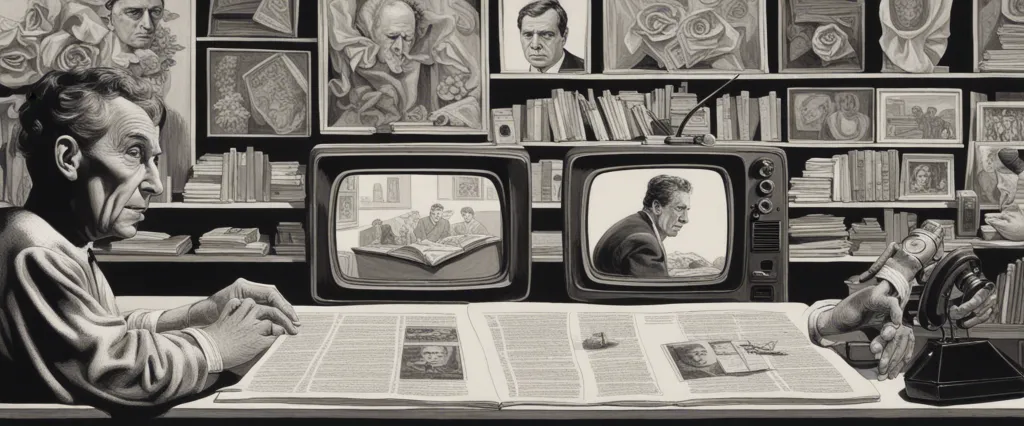——Amusing Ourselves to Death by Neil Postman & Understanding Media by Marshall McLuhan

In the ever-evolving landscape of media and technology, two seminal books have emerged as thought-provoking analyses of our modern communications landscape: “Amusing Ourselves to Death” by Neil Postman and “Understanding Media” by Marshall McLuhan. Published decades apart, these books delve deep into the impact of mass media on our society, unraveling the subtle nuances and consequences of our addiction to entertainment and information consumption.
“Amusing Ourselves to Death” was first published in 1985, with Neil Postman dissecting the effects of television on our collective consciousness and its transformation of cultural discourse. On the other hand, “Understanding Media” by Marshall McLuhan was published in 1964, presenting a groundbreaking exploration of media ecology and how communication technologies shape our perception, cognition, and social structures. Despite their temporal disparity, both Postman and McLuhan offer invaluable insights and timeless observations that continue to resonate in our digital age.
Within the pages of “Amusing Ourselves to Death,” Postman argues that television has transformed our society into a culture that values entertainment and triviality over critical thinking and reasoned discourse. Drawing upon historical examples and a deep understanding of media ecology, he warns of the dangers of being consumed by a medium that presents information in a fragmented, superficial, and entertainment-driven manner. Postman’s voice acts as a wake-up call, urging readers to question the very nature of the medium through which we receive information and its implications on our intellectual capabilities as individuals and as a society.
On the other hand, McLuhan’s “Understanding Media” is a pioneering work that delves into the profound influence of mediums of communication and how they shape our perception, behavior, and societal structures. By introducing the now-famous phrase “the medium is the message,” McLuhan highlights the importance of understanding the intrinsic qualities and biases embedded within different communication technologies. Through his unique perspective, he unveils the ways in which media shapes not just the content it delivers, but also our perceptions, interactions, and even the organization of our civilization itself.
Although “Amusing Ourselves to Death” and “Understanding Media” explore similar themes surrounding the impact of media on society, they diverge in their approach and analysis. While Postman’s work primarily focuses on the detrimental effects of television and the entertainment culture it fosters, McLuhan takes a broader lens by considering various mediums and their profound influence on our existence. Nevertheless, both authors share a common thread in their concern for the loss of critical thinking, the erosion of intellectual discourse, and the potential consequences of our media-saturated environment.
In this comparative study, we shall delve deeper into the ideas presented by Postman and McLuhan, examining the similarities and differences in their analysis of media and its impact on society. Through a critical examination of their works, we hope to shed light on the ongoing debates surrounding media consumption and the need for a more mindful approach to our ever-expanding media ecosystem. As we embark on this journey into the world of media theory, let us unravel the messages conveyed by both Postman and McLuhan and reflect upon how they resonate in the world we live in today.
Brief Summary of Two Books
Amusing Ourselves to Death by Neil Postman
“Amusing Ourselves to Death” by Neil Postman is a thought-provoking critique of how media and entertainment have transformed public discourse and culture. Postman argues that the transition from a print-based society to a television-centered one has had profound consequences on our understanding of information, truth, and meaningful conversation.
The book contends that the nature of television as a medium is inherently distracting, superficial, and focused on entertainment rather than substance. Postman draws a distinction between “serious discourse,” which involves reasoned arguments and critical thinking, and “entertainment discourse,” which prioritizes amusement and emotional appeal. He argues that the increasing dominance of entertainment in all aspects of our lives, including news, politics, education, and religion, has led to the erosion of reasoned public debate and the devaluation of knowledge.
Postman uses historical examples, such as the contrasting public debates surrounding the Lincoln-Douglas debates (print-based discourse) and the Kennedy-Nixon debates (television-dominated discourse), to illustrate the impact of media on society. He asserts that television’s emphasis on image, spectacle, and soundbites has changed the way we think and consume information. In his view, television has reduced complex issues to bite-sized, easily digestible fragments that lack depth, nuance, and context.
Furthermore, Postman suggests that the relentless pursuit of entertainment has bred a culture of passivity and indifference, where serious issues are trivialized, and attention spans are shortened. He argues that the constant bombardment of entertainment has numbed our ability to engage in deep, reflective thinking and critically analyze complex problems.
In the latter part of the book, Postman explores the idea of how technology shapes culture and raises questions about the role of media in society. He encourages readers to be aware of the potential dangers and consequences of a society overly reliant on entertainment and superficial distractions.
Overall, “Amusing Ourselves to Death” serves as a cautionary tale about the impact of media on our intellectual and cultural life, urging readers to be vigilant about preserving serious discourse and critical thinking in the face of an increasingly entertainment-oriented society.
Understanding Media by Marshall McLuhan
Understanding Media: The Extensions of Man by Marshall McLuhan is a groundbreaking and influential book published in 1964 that explores the effects of media on human civilization, culture, and perception. McLuhan argues that media are not just tools or channels of communication, but rather active forces that shape society and the human mind in profound ways.
McLuhan introduces the concept of “media extensions,” stating that each medium (such as print, television, or the internet) extends or amplifies certain human senses, capabilities, and social structures, while simultaneously obsolescing others. For example, print media extends our visual sense and encourages linear, rational thinking, but it diminishes our oral and auditory senses.
The book describes how media influence our perception of time, space, and social organization. McLuhan suggests that print media fostered individualism, rationality, and a linear worldview, whereas electric media (such as television) promote collective consciousness, global interconnectedness, and a fragmented, nonlinear worldview.
McLuhan also explores different media and their effects on society, such as the impact of the alphabet and the printing press on the formation of nation-states, the rise of visual and auditory dominance in television, the rise of the medium of advertising, and the influence of new electronic media on human perception and cognition.
Throughout the book, McLuhan challenges conventional assumptions about media and encourages readers to critically examine the power and influence of various forms of communication. He famously states, “The medium is the message,” meaning that the characteristics and biases of a medium have a greater impact on society than the actual content it delivers.
Understanding Media is known for its provocative ideas and insightful observations about the role of media in shaping human culture. It remains an important and influential work in media theory and continues to inspire discussions about the social, cultural, and psychological effects of media in the digital age.
Comparison between Two Books

Similarities in Media
Both “Amusing Ourselves to Death” by Neil Postman and “Understanding Media” by Marshall McLuhan analyze the impact of media on society and share several similarities in their perspectives on this topic.
1. Media as an influential force: Both books emphasize the significant influence of media on individual and collective behavior, beliefs, and values. They argue that media shapes our perception of reality and has the power to shape public opinion and political discourse.
2. The medium as the message: McLuhan and Postman both argue that the medium through which information is conveyed is as important as the content itself. McLuhan famously states in his book that “the medium is the message,” emphasizing that the form of communication profoundly influences our understanding and experience of the message. Postman also contends that different media formats (like print, television, or the internet) have different characteristics and ultimately shape the content they deliver.
3. Decline of serious discourse: Both authors highlight the trend towards trivial and superficial content in the media. Postman in “Amusing Ourselves to Death” argues that television prioritizes entertainment and spectacle over substantive information, leading to a decline in the quality of public discourse. McLuhan, in “Understanding Media,” discusses how the nature of various media technologies promotes instant gratification and fragmented attention, diminishing the possibility for deep reflection.
4. The pervasiveness of advertising: Both books address the overwhelming presence of advertising within the media landscape. They explain how advertising shapes content, distorts reality, and manipulates public perception. Both authors contend that commercial interests often overshadow meaningful content, thereby affecting society’s ability to engage in critical thinking and informed decision-making.
5. Fragmentation and reconfiguration of knowledge: Both Postman and McLuhan discuss how media technologies fragment information and reshape how we acquire knowledge. McLuhan uses the term “mosaic” to describe the fractured nature of information in the electronic age, while Postman argues that television’s visual medium discourages sustained, logical arguments and complex thought processes.
Overall, these books converge in their exploration of media’s influence on society, particularly relating to the impact of the medium itself, the decline of serious discourse, advertising’s role, and the fragmentation of knowledge. They provide valuable insights into the way media shapes our perceptions, behaviors, and values.
Divergences in Media
Amusing Ourselves to Death by Neil Postman and Understanding Media by Marshall McLuhan are two seminal works that explore the impact of media on society and culture. While both books address similar themes, they diverge in their analysis and conclusions, offering distinct perspectives on the influence of media in shaping human communication and consciousness.
One of the key divergences between the two works lies in their respective historical contexts. Understanding Media, published in 1964, was written during the rise of television as a dominant medium, while Amusing Ourselves to Death, released in 1985, arrived when television had become firmly entrenched in society. This gap of more than 20 years offers different vantage points for the authors to assess the role of media and its effect.
Marshall McLuhan’s Understanding Media presents a pioneering and more optimistic perspective on media’s influence. McLuhan argues that the medium is the message, emphasizing how the medium itself shapes our perception and understanding of the world. He argues that different types of media, such as the printed word, television, and the telephone, create distinct cognitive environments, which in turn influence human behavior and culture. McLuhan believes that media has the potential to connect people from different parts of the world, foster global consciousness, and create a “global village.” His work celebrates the potential of media to revolutionize society, communication, and consciousness.
On the other hand, Neil Postman’s Amusing Ourselves to Death takes a more critical stance. Postman argues that television, with its focus on entertainment and spectacle, has reshaped public discourse and transformed our relationship with information. He argues that while McLuhan’s perspective was valid during the era of the printed word, the advent of television has shifted the nature of public discourse from rational and deliberative to trivial and superficial. For Postman, the medium’s emphasis on visuals and entertainment has had a detrimental effect on how we consume and understand information. He highlights how television, through its fragmented and simplistic content, reduces complex issues into bite-sized, entertaining soundbites, undermining critical thinking and civic engagement.
Another important divergence between the two books relates to their perspectives on the role of technology. McLuhan’s work features an almost utopian outlook towards the potential of media technology to unite humanity; he sees media as a force that can transcend cultural boundaries and foster harmony. In contrast, Postman’s Amusing Ourselves to Death takes a more cautionary stance, highlighting how the uncritical adoption of technology may lead to unintended consequences, such as the decline of serious discourse and the rise of a passive, hedonistic society.
In conclusion, while both Amusing Ourselves to Death by Neil Postman and Understanding Media by Marshall McLuhan explore the impact of media, they diverge in their analysis and conclusions. McLuhan embraces a more optimistic perspective on media’s influence, celebrating its potential to connect humanity. In contrast, Postman adopts a critical stance, scrutinizing the negative consequences of relying on television as a dominant medium. These divergent viewpoints offer contrasting insights into the role of media in shaping communication, culture, and consciousness.

Conclusion
Both “Amusing Ourselves to Death” by Neil Postman and “Understanding Media” by Marshall McLuhan are influential books that offer unique perspectives on the impact of media on society. Ultimately, the choice between these two books depends on personal interests and the specific areas of media and culture one wishes to explore.
Neil Postman’s “Amusing Ourselves to Death” explores the concept of how our media-saturated culture has transformed public discourse and the way we perceive information. Postman argues that television, with its focus on entertainment and brevity, negatively impacts our ability to engage in critical thinking and meaningful conversations. This insightful critique of media is particularly relevant in the digital age and continues to resonate with readers concerned about the effects of mass media on modern society.
On the other hand, Marshall McLuhan’s “Understanding Media” takes a broader approach by examining how different media technologies shape our thoughts, behaviors, and relationships. McLuhan introduced the famous phrase “the medium is the message,” emphasizing the idea that media forms have significant influences beyond the content they convey. This book delves into the historical development of various media, from the written word to television, and offers a unique perspective on the interconnectedness of culture, technology, and communication.
Both books are valuable and have had a lasting impact on media studies. If you are interested in a critical analysis of contemporary media and its effect on society, “Amusing Ourselves to Death” might be a better choice. However, if you are intrigued by the broader implications of media technology and its role in shaping culture, “Understanding Media” would be a worthy read.


